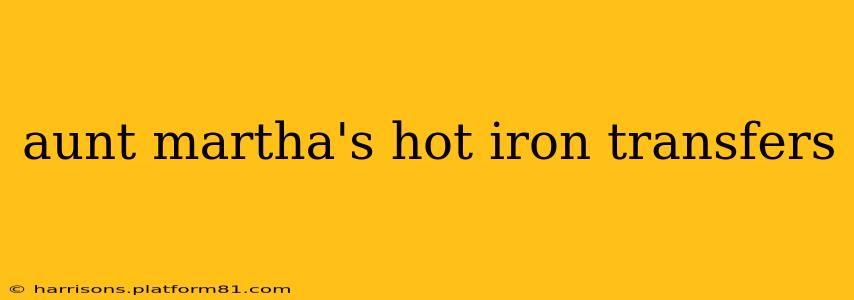Aunt Martha's Hot Iron Transfers hold a special place in the hearts of many crafters, representing a simpler time of creative expression and personalized home décor. These aren't just transfers; they're a gateway to memories of handmade gifts, customized clothing, and the satisfying thunk of a hot iron pressing a design onto fabric. This guide delves into the history, application, and enduring appeal of Aunt Martha's Hot Iron Transfers, exploring why they remain a beloved crafting staple.
What are Aunt Martha's Hot Iron Transfers?
Aunt Martha's Hot Iron Transfers were (and in some cases, still are) a popular method of transferring images onto fabric using heat and pressure. Unlike screen printing or other more advanced techniques, these transfers were remarkably accessible, requiring only an iron and a piece of fabric. The designs, often featuring charming florals, whimsical animals, or holiday motifs, were printed onto special transfer paper. This paper, when heated with an iron, would release the image onto the fabric, leaving behind a permanent design. The simplicity and ease of use made them a favorite among crafters of all skill levels.
How Do Aunt Martha's Hot Iron Transfers Work?
The process was (and remains) surprisingly straightforward:
- Prepare your fabric: Ensure the fabric is clean, ironed, and wrinkle-free.
- Position the transfer: Carefully place the transfer paper, image-side down, onto the fabric where you want the design to appear.
- Ironing: Use a hot, dry iron (avoid steam) and apply firm, even pressure for the recommended time (usually specified on the packaging). Avoid sliding the iron back and forth.
- Peel: After the specified cooling time, carefully peel away the backing paper to reveal your transferred design.
Where Can I Find Aunt Martha's Hot Iron Transfers?
Finding Aunt Martha's original transfers can be a bit of a treasure hunt. While they were once widely available in craft stores, their popularity has fluctuated over time. You might have luck searching online marketplaces like eBay or Etsy, where sellers often offer vintage and new-old-stock transfers. Some craft supply stores may also carry similar hot iron transfer products from other brands.
Are Aunt Martha's Hot Iron Transfers Still Made?
While the original Aunt Martha's brand may not be as prevalent as it once was, the concept of hot iron transfers persists. Many companies produce similar transfer papers with a wide range of designs. You can find modern alternatives at various craft stores both online and in physical locations.
What Types of Fabrics Work Best with Aunt Martha's Hot Iron Transfers?
Aunt Martha's Hot Iron Transfers generally work best on natural fabrics like cotton, linen, and blends that contain a significant percentage of natural fibers. Synthetics can sometimes present challenges, so it's always best to test on a scrap piece of fabric first. The success of the transfer also depends on the quality of the fabric; smooth, tightly woven fabrics yield the best results.
Can I Use an Iron-On Transfer on Any Fabric?
No. The suitability of the fabric is crucial to a successful iron-on transfer. Synthetics, very loosely woven fabrics, and delicate materials are not ideal. Always test on a scrap piece of fabric first to see how it reacts to the heat and pressure.
How Do I Remove an Aunt Martha's Hot Iron Transfer?
Removing a transferred image can be challenging. Depending on the fabric and the transfer itself, you might find that gentle scrubbing with detergent and water or a fabric-safe bleach will partially remove the image, though complete removal is often difficult.
Conclusion: A Legacy of Creativity
Aunt Martha's Hot Iron Transfers represent more than just a crafting technique; they represent a connection to a simpler, more hands-on era of creativity. While the original brand may be less readily available, the spirit of personalized crafting lives on through the many similar products now available. So, whether you're rediscovering a childhood craft or exploring a new creative outlet, hot iron transfers offer a fun, accessible way to add a personal touch to your projects.
